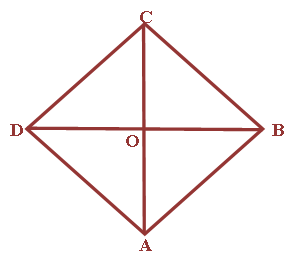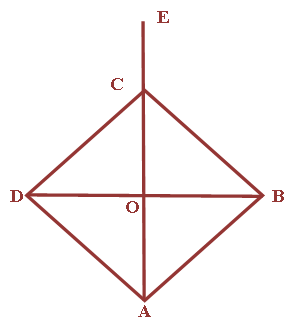The Diagonal of a Rhombus are Perpendicular to Each Other










The Diagonal of a Rhombus are Perpendicular to Each Other
| Theorem: The diagonal of a rhombus are perpendicular to each other | |
Given: A rhombus ABCD in which AC and BD are diagonals. To Prove: AC and BC intersect perpendicularly. Proof: As ABCD is a rhombus Therefore it is a parallelogram
Also diagonals of a parallelogram bisect each other.
In BO = DO [ From Equation (2)] BC = CD [ From Equation (1)] OC = OC [ Common ] Therfore But
Similarly we can prove that Hence Proved. |  |
| Theorem: Show that if the diagonals of a quadrilateral bisect each other at right angles, then it is a rhombus. | |
Given: A quadrilateral ABCD such that AC and CD bisect at Right angle. AO = OC and BO = OD ....................(1) AC To Prove: ABCD is a rhombus. Proof: In AO = OC [ From Equation (1)] BO = OD [ From Equation (1)] Therefore
But they are alternate angles When AB and CD are straight lines and AC is the transversal
Similarly we can Prove that AD || BC As both pairs of opposite sides are equal Therefore ABCD is a ||gm In AO = OC [ From Equation (1)] BO = OB [ Common] Therefore AB = BC [CPCT] As ABCD is a IIgm and the adjacent sides are equal AB = BC Therefore ABCD is a rhombus |  |
| Illustration: ABCD is a rhombus in which diagonal AC is produced to E . If | |
Solution: As ABCD is a rhombus and we know diagonals of rhombus bisect at right angle. In
As every rhombus is a parallelogram, Therefore CD || AB
In the figure
In
Hence |  |
Students / Parents Reviews [10]
My experience with Abhyas is very good. I have learnt many things here like vedic maths and reasoning also. Teachers here first take our doubts and then there are assignments to verify our weak points.

Shivam Rana
7thAbhyas Methodology is very good. It is based on according to student and each child manages accordingly to its properly. Methodology has improved the abilities of students to shine them in future.

Manish Kumar
10thMy experience was very good with Abhyas academy. I am studying here from 6th class and I am satisfied by its results in my life. I improved a lot here ahead of school syllabus.

Ayan Ghosh
8thAbout Abhyas metholodology the teachers are very nice and hardworking toward students.The Centre Head Mrs Anu Sethi is also a brilliant teacher.Abhyas has taught me how to overcome problems and has always taken my doubts and suppoeted me.

Shreya Shrivastava
8thBeing a parent, I saw my daughter improvement in her studies by seeing a good result in all day to day compititive exam TMO, NSO, IEO etc and as well as studies. I have got a fruitful result from my daughter.

Prisha Gupta
8thMy experience with Abhyas academy is very good. I did not think that my every subject coming here will be so strong. The main thing is that the online tests had made me learn here more things.

Hiya Gupta
8thIt has a great methodology. Students here can get analysis to their test quickly.We can learn easily through PPTs and the testing methods are good. We know that where we have to practice

Barkha Arora
10thOne of the best institutes to develope a child interest in studies.Provides SST and English knowledge also unlike other institutes. Teachers are co operative and friendly online tests andPPT develope practical knowledge also.

Aman Kumar Shrivastava
10thIt was good as the experience because as we had come here we had been improved in a such envirnment created here.Extra is taught which is beneficial for future.

Eshan Arora
8thI have spent a wonderful time in Abhyas academy. It has made my reasoning more apt, English more stronger and Maths an interesting subject for me. It has given me a habbit of self studying
